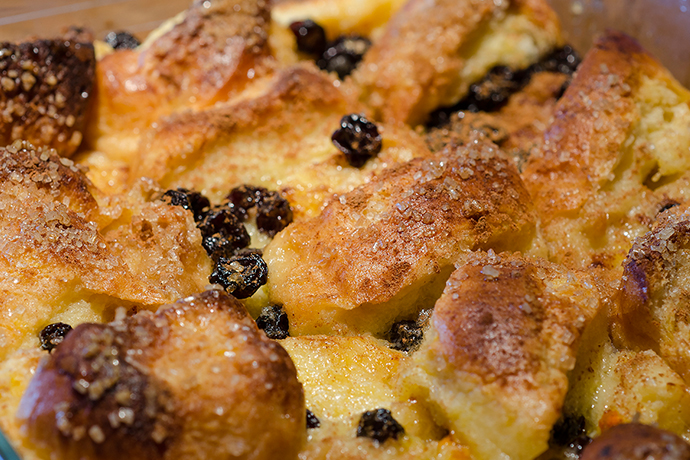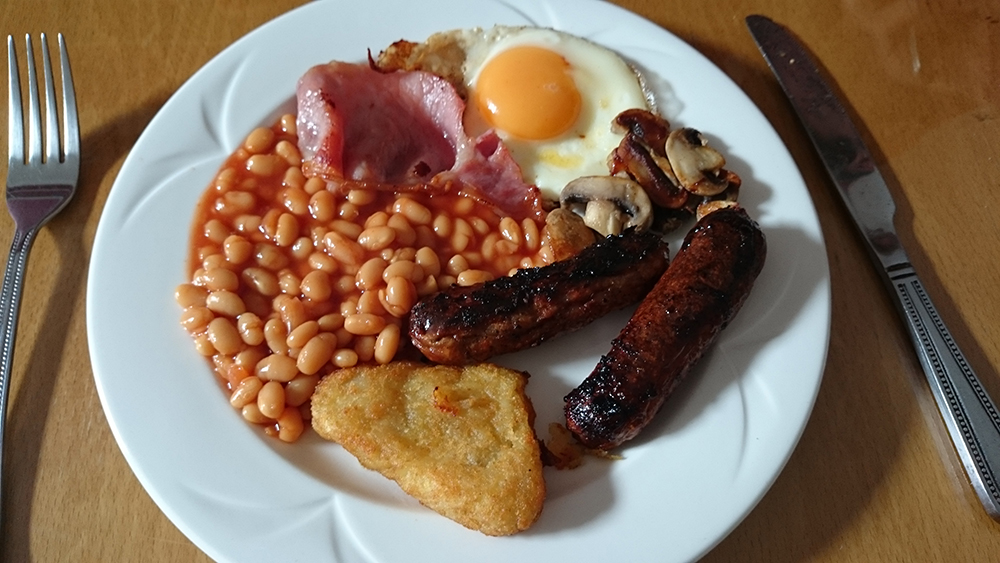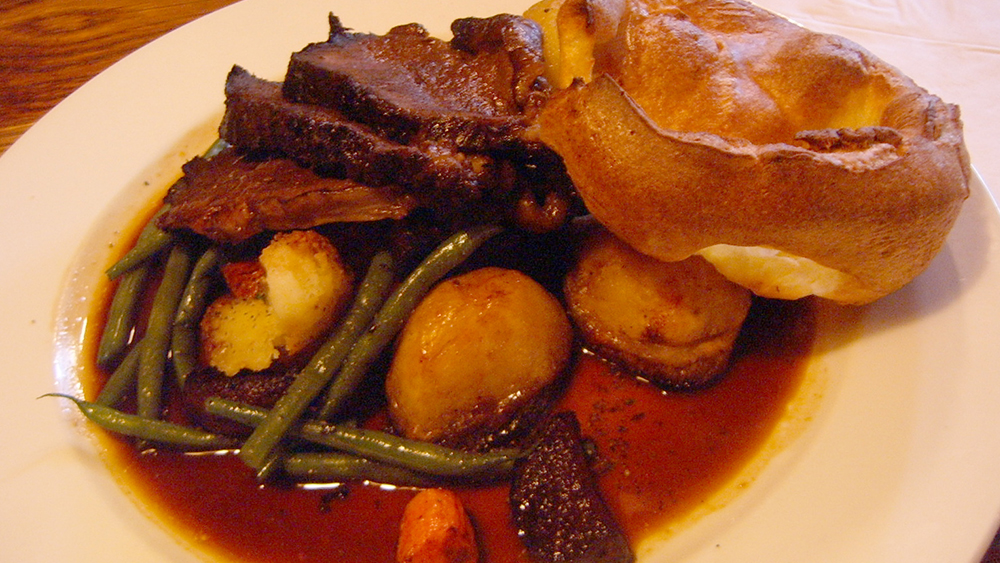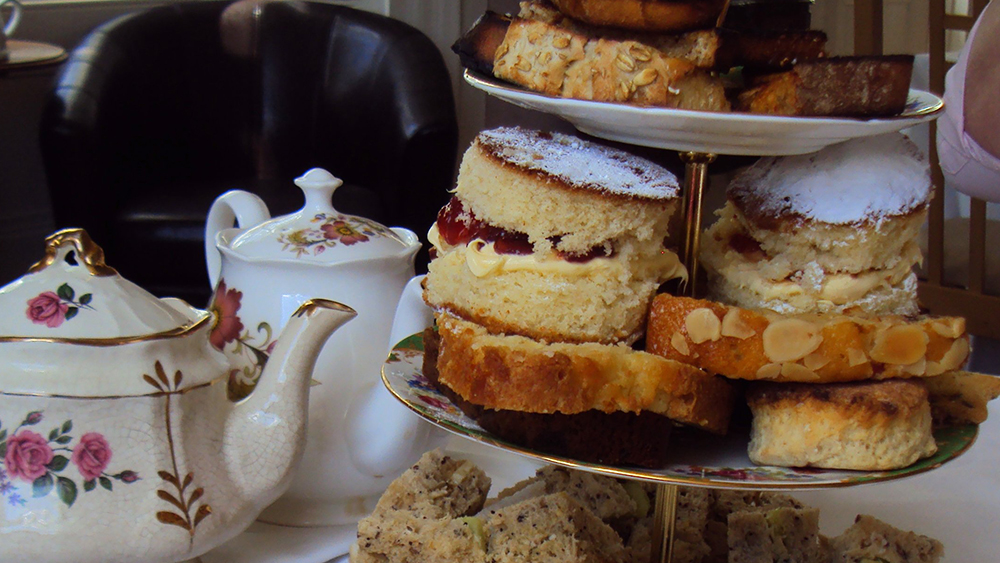Blog

English food – A guide for international students
14-07-2016

Traditional English food is usually filling and warming, this is due to the cool climate of the UK. As it’s often chilly and rainy, we like to feel warmed up and full! Below are a few different types of English food which you may like to try whilst you are in the UK.
Fish & Chips
This is a popular dish which you must go to a ‘fish & chip shop’ to buy. It is seen as the original English ‘take-away’. Frying fish is an art form and people travel for miles to go to a popular fish and chip shop.
The fish is battered, and served with chips. You can have a variety of things to accompany the fish and chips, such as bread, mushy peas, curry sauce, gravy, tomato ketchup, vinegar, salt, and other condiments. British people usually have this as a treat, as it is quite high in fat and very filling. It is a great British tradition to have fish and chips at the seaside. Many people believe they taste better there because the fish is fresh and the salty sea air improves the flavour. You can find out more about the history of fish and chips here.
Bangers & Mash
This dish is sausage (bangers) and mashed potato, and is usually served with onion gravy. Sausages are a very popular English food and many regions make their own variety of sausage (e.g. Lincolnshire sausage and Cumberland sausage).
Sausages were nicknamed “bangers” during the Second World War. Because meat was scarce during rationing, sausages had a high water content which meant that they were liable to explode when cooked as the water turned to steam. For more interesting facts about English sausages take a look at this article.
Full English Breakfast
A traditional English breakfast (also known as a ‘full English breakfast’ or a ‘fry up’) is a very large breakfast which is intended to fill you up for the day. It is made up of black pudding, bacon, sausages, beans, eggs, toast, tomatoes (grilled), mushrooms, hash browns and is usually accompanied by a cup of tea of coffee. Full English breakfasts are special treats and are usually reserved for weekends or holidays. You can find out more about the history of the ‘English breakfast’ here.
A classic full English breakfast
Classic Pie
A classic pie featuring a hot savoury filling, entirely encased in pastry truly is a favorite English food for many. If you go into a English pub which serves food you are sure to find one on the menu. Do not be fooled by stew in a bowl with a puff pastry lid on top – that is not a true pie. A true pie must be entirely cased in pastry.
Pies come in a variety of traditional fillings – chicken, meat and potato, steak and kidney, game… the list is endless! Recently, the popularity of pies has seen a resurgence and you may see some pies with non-traditional fillings such as chorizo and butter bean, or chicken tandoori.
Pies come with two types of pastry; puff and shortcrust. Puff pastry has layers of butter in the dough and puffs up really nicely when you bake it. Shortcrust pastry is very dense and does not puff up during baking.
To find out more about the great British pie, take a look at this article.
Shepherd’s Pie
This dish is usually served in the winter and it comprises of minced lamb meat in a stock, with vegetables cooked into it. It is topped with mashed potato and cheese, and baked in the oven. It usually comes accompanied with seasonal vegetables. Shepherd’s pie is made with lamb, if you use beef, then it is known as a ‘cottage pie’. Here are 10 other things that you didn’t know about shepherd’s pie.
Pork pie
Pork pies have been around since the 1300’s when it was invented as a transportable dish which could be eaten cold and would last (i.e. not rot so quickly). A classic pork pie has a hand-formed hot water crust pastry and a seasoned pork filling. It is topped up with meat jelly after baking. The jelly is key as it acts as a protective layer that keeps out airborne germs and stabilises the pie so it can be transported without breaking. You can find out more about English pork pies here.
Steak and Kidney Pudding
Steak and kidney pudding is a stodgy, filling dish which has been made in the UK since the 17th century. It consists of a meat (beef steak and kidneys) and gravy filling in a suet pastry shell. The pudding is steamed over boiling water using the same method as steamed pudding (see below) and served with seasonal vegetable and potatoes. You can get different fillings (such as steak and mushroom) but steak and kidney is the most popular in the UK. You can read more about Britain’s love affair with savoury puddings here.
Sunday Roast
Many English families will have a ‘roast dinner’ on a Sunday, known as a ‘Sunday roast’. Traditionally, a Sunday roast refers to beef however it is very much a family meal and different families have different traditions of what they will eat. The basics of a roast are roasted meat (beef, chicken, lamb, or pork), potatoes (also roasted), a variety of seasonal vegetables, a Yorkshire pudding, and gravy. It was traditionally made to use up all the food in the house at the end of the week to avoid waste. Find out more about the history of the ‘Sunday roast’ here.
A traditional Sunday roast. Photo by Annie Mole
Strawberries and Cream
Strawberries and cream are traditionally eaten in the UK during the summer months when strawberries are grown in the UK in abundance! They are a popular feature of the Wimbledon tennis tournament and English picnics. To find out about the history of strawberries and cream at Wimbledon, read this article.
Eton Mess
Eton mess is a traditional English dessert consisting of strawberries, pieces of meringue, and cream, which has been served at Eton College’s annual cricket game against the pupils of Harrow School since the 1930’s. There are rumours that the dish was invented when a Labrador dog sat on a picnic basket containing a strawberry cream meringue and squashed the dessert. This may or may not be true but either way it’s a nice story! To find out more, read here.
Trifle
Trifle is traditionally served on Christmas day but can be eaten at any time of the year. It is a layered dessert that is made of jelly, custard, cream, sherry-soaked sponge, and fruit. It can be eaten on its own or with cream or custard.
Victoria Sponge
This is a simple cake that is a national favourite. It is a sponge cake, sliced in half and sandwiched with jam and sometimes cream or buttercream. The cake is then dusted with icing sugar. Usually a hint of vanilla is added to the sponge to give it a lovely flavour.
It is a traditional English teatime treat which became popular during the reign of Queen Victoria. It is widely believed that it is a so called ‘Victoria sponge’ because it was Queen Victoria’s favourite cake. You can find out more about the Victoria sponge here.
Crumble
A crumble comes in all sorts of flavours and is usually made from seasonal British fruit such as apples, rhubarb, gooseberries or blackberries. The fruit is baked with a sweet topping made of flour, butter, sugar and flavourings. When it’s baked the topping is crumbly, hence the name crumble! It is served warm with custard, cream, or ice-cream (it can be eaten without these but it’s not quite as good!).
Steamed Puddings
Steamed puddings have been popular in Britain for centuries. Originally, they were boiled in a cloth in the same pot as a savory meat dish. Since the Victorian period, they have been made in pudding basins and cooked over water and steamed rather than boiled in the water.
There are two types of steamed pudding: sponge puddings and suet puddings.
Sponge puddings are made with butter, flour and eggs produce a dense sponge pudding topped with sauce. Sponge puddings have a sauce that combines with the sponge to produce a sticky top. Treacle sponge and chocolate sponge puddings are both popular in the UK.
As the name suggests, suet puddings contain suet (animal fat) which gives the puddings a dense and crumbly texture. Spotted dick is a popular suet pudding. ‘Spotted’ refers to raisins and currants in the suet dough and ‘dick’ is an old colloquial word for pudding. Jam roly poly is also a popular suet pudding as is the traditional English Christmas pudding which contains a dense mixture of dried fruits and alcohol. Christmas puddings are traditionally served ablaze by pouring brandy over the pudding and lighting the fumes. All English steamed puddings are served with lashings of real custard!
You can find out more about the history of traditional steamed puddings here.
Bread and Butter Pudding
Bread and butter pudding is a traditional way to use up left over bread. It is a cheap and delicious treat which is still popular in the UK today. Stale bread is sliced up and laid in a baking dish. A mixture of milk, cream, sugar, sultanas and cinnamon is then poured over and the whole lot is baked.
Afternoon Tea
The Duchess of Bedford started the tradition of afternoon tea (also known as ‘cream tea’ or ‘high tea’) in 1840 and has it has remained popular ever since. You can find out more here. There isn’t a set menu for a traditional afternoon tea menu however you can expect a selection of sandwiches, scones and a variety of sweet items.
There are some excellent tea rooms in the UK and it is well worth visiting as many as possible whilst you are travelling around. This article has compiled a list of 50 of the best of them. We can personally recommend Bettys – a Yorkshire favourite!
A classic afternoon tea



